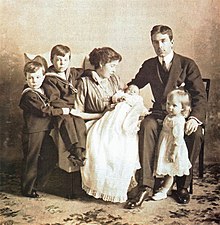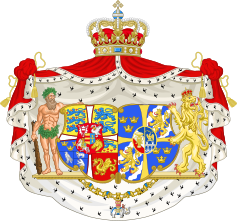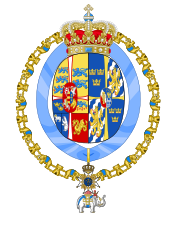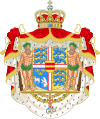Ingrid of Sweden
| Ingrid of Sweden | |
|---|---|
Queen consort of Denmark | |
| Tenure | 20 April 1947 – 14 January 1972 |
| Born | 28 March 1910 Stockholm Palace, Stockholm, Sweden |
| Died | 7 November 2000 (aged 90) Fredensborg Palace, Fredensborg, Denmark |
| Burial | 14 November 2000 , Denmark |
| Spouse | |
Margaret of Connaught | |
| Signature | |
Ingrid of Sweden (Ingrid Victoria Sofia Louise Margareta; 28 March 1910 – 7 November 2000) was
Born into the
In 1947, her husband became king on his father's death. As queen, Ingrid reformed the traditions of Danish court life, abolished many old-fashioned customs at court and created a more relaxed atmosphere at official receptions. King Frederik IX died in 1972, and Ingrid's daughter Margrethe became queen.
Early life

Ingrid was born on 28 March 1910, at the
She was baptised Ingrid Victoria Sofia Louise Margareta in Slottskyrkan (the Royal Chapel) in Stockholm, Sweden on 5 May 1910. Her godparents were: the
Ingrid and her family lived in apartments in the Royal Palace in Stockholm, in a mansion at
Ingrid was taught
Marriage

The question of Ingrid's marriage was a hot topic of conversation in the 1920s. She was matched with various foreign royalties and was seen by some as a possible wife for the heir apparent to the British throne, the Prince of Wales, who was her second cousin.[5] Her mother, Margaret of Connaught, and the then-Prince of Wales' father, King George V, were first cousins, both being grandchildren of Queen Victoria. In 1928, Ingrid met the Prince of Wales in London. However, no engagement took place.[6] She was also considered as a match for Prince George of the United Kingdom, the fourth son of King George V.
On 15 March 1935, shortly before her 25th birthday, her engagement to Frederik, the Crown Prince of Denmark and Iceland, who was 11 years her senior, was announced. They had gotten engaged in private in the beginning of February.[7] They were related in several ways. As descendants of Oscar I of Sweden, they were third cousins. Through Leopold, Grand Duke of Baden, they were third cousins. And finally through Paul I of Russia, Frederik was a fourth cousin of Ingrid's mother.
The couple was married in
Among the guests at the wedding were Frederik's parents,
The Swedish royal barge Vasaorden transported the couple to Dannebrog, the Danish royal yacht, on 24 May. Two days later, they arrived in Copenhagen aboard the yacht before leaving for a honeymoon to Rome. Her wedding was one of the greatest media events of the day in Sweden in 1935, and received so much attention that the media were criticised for it. [citation needed] Ingrid also appeared on the radio in 1935 and read a poem, something that was also given much attention. [citation needed]
Crown Princess
While she was Crown Princess, she was the official patron of the Girl Guides (1936), after having taken, and passed, the same tests all applicants were given. In 1940, before the occupation, she was the leader of the Danske Kvinders Beredskab (The Danish Women's war-effort society).[8] During the German occupation of Denmark in World War II, Ingrid, with her personal courage and integrity, influenced the Danish Royal House and its conduct in relation to the occupation forces, and won great popularity as a symbol of silent resistance and public patriotic moral. She showed solidarity toward the Danish population, and could often be seen on her bicycle or with her baby carriage on the streets of Copenhagen during the war. Her open defiance of the occupation forces made her grandfather, King Gustav of Sweden, worry about the risks, and in 1941, he sent a demand to her to be more discreet "for the sake of the dynasty" and its safety, but she reacted with anger and refused to obey, and she had the support of her spouse, who shared her views. One display of defiance shown by Ingrid was her positioning of the flags of Denmark, Sweden and the United Kingdom in the window of the nursery at Amalienborg, the royal residence in the centre of Copenhagen.[citation needed]
Queen consort

Upon her husband's accession to the throne on 20 April 1947, she became the Queen of Denmark. As such, she reformed the traditions of Danish court life, abolished many old-fashioned customs at court and created a more relaxed atmosphere at official receptions. She was interested in gardening and art, and renovated the
Widowed queen

In 1972, King Frederik IX died, and Ingrid was widowed at the age of 61. Her elder daughter, aged 31, became the new queen, and Ingrid now assumed a position as family matriarch. That same year, after having sworn to respect the Danish constitution, she was appointed Rigsforstander (formal regent) and representative of the monarch whenever her daughter (and later her grandsons) were absent, a task she performed on many occasions. This was exceptional; previously, only the Crown Prince had been allowed to act as regent in the absence of the monarch.
She was patron of a long line of social organizations, positions which, one after another, she eventually left to Princess Benedikte as years passed: Røde Kors, Ældre Sagen, Red Barnet, Løgum Klosters Refugium, and Fonden for Træer og Miljø. She also founded the organizations Kong Frederik og Dronning Ingrids fond til humanitære og kulturelle formål, Ingridfondet for South Jutland, Det kgl. Grønlandsfond, and Dronning Ingrids Romerske Fond til støtte af kulturelle og videnskabelige formål. She was described as dutiful, well-prepared and energetic.
Death

Queen Ingrid died on 7 November 2000 at
Issue
Queen Ingrid and King Frederik IX had three daughters, ten grandchildren and twenty-two great-grandchildren.[citation needed]
- Henri de Laborde de Monpezaton 10 June 1967. They have two sons and eight grandchildren.
- Prince Richard of Sayn-Wittgenstein-Berleburgon 3 February 1968. They have three children and five grandchildren.
- King Constantine II of Greeceon 18 September 1964. They have five children and nine grandchildren.
Honours

 Personal Standard of Queen Ingrid, introduced in 1948 and used until her death in 2000.
Personal Standard of Queen Ingrid, introduced in 1948 and used until her death in 2000.National
 Royal Order of the Seraphim (LoK av KMO)[citation needed]
Royal Order of the Seraphim (LoK av KMO)[citation needed] Royal Family Order of King Gustav V[citation needed]
Royal Family Order of King Gustav V[citation needed] Royal Family Order of King Gustav VI Adolf[citation needed]
Royal Family Order of King Gustav VI Adolf[citation needed] Royal Family Order of King Carl XVI Gustaf[citation needed]
Royal Family Order of King Carl XVI Gustaf[citation needed] Sweden: Recipient of 50th Birthday Badge Medal of King Carl XVI Gustaf[citation needed]
Sweden: Recipient of 50th Birthday Badge Medal of King Carl XVI Gustaf[citation needed] Sweden: Recipient of 90th Birthday Badge Medal of King Gustav V[citation needed]
Sweden: Recipient of 90th Birthday Badge Medal of King Gustav V[citation needed] Denmark: Knight Grand Cross with Collar of the Order of the Elephant (R.E.)
Denmark: Knight Grand Cross with Collar of the Order of the Elephant (R.E.) Denmark: Knight Grand Commander of the Order of the Dannebrog (S.Kmd.)
Denmark: Knight Grand Commander of the Order of the Dannebrog (S.Kmd.) Royal Family Orderof King Christian X
Royal Family Orderof King Christian X Royal Family Orderof King Frederik IX
Royal Family Orderof King Frederik IX Danish Red Cross Badge of Honor (D.r.K.H.)[citation needed]
Danish Red Cross Badge of Honor (D.r.K.H.)[citation needed] Medal of the 100th Anniversary of the Birth of King Frederik IX[citation needed]
Medal of the 100th Anniversary of the Birth of King Frederik IX[citation needed] Silver Jubilee Medal of Queen Margrethe II[citation needed]
Silver Jubilee Medal of Queen Margrethe II[citation needed] Silver Anniversary Medal of Queen Margrethe II and Prince Henrik[citation needed]
Silver Anniversary Medal of Queen Margrethe II and Prince Henrik[citation needed] 50th Birthday Medal of Queen Margrethe II[citation needed]
50th Birthday Medal of Queen Margrethe II[citation needed] King Christian X Memorial Medal[citation needed]
King Christian X Memorial Medal[citation needed]
Foreign
 Order of Honour for Services to the Republic of Austria[11]
Order of Honour for Services to the Republic of Austria[11] Order of Leopold I
Order of Leopold I Egyptian Royal Family: Dame Grand Cross of the Order of the Virtues, Supreme Class[citation needed]
Egyptian Royal Family: Dame Grand Cross of the Order of the Virtues, Supreme Class[citation needed] Ethiopian Imperial Family: Dame Grand Officer of the Order of the Queen of Sheba
Ethiopian Imperial Family: Dame Grand Officer of the Order of the Queen of Sheba Finland: Grand Cross with Collar of the Order of the White Rose of Finland[12]
Finland: Grand Cross with Collar of the Order of the White Rose of Finland[12] France: Grand Cross of the Legion of Honour[citation needed]
France: Grand Cross of the Legion of Honour[citation needed]- Greek Royal Family: Dame Grand Cross of the Order of Saints Olga and Sophia
 Germany: Grand Cross, Special Class of the Order of Merit of the Federal Republic of Germany[citation needed]
Germany: Grand Cross, Special Class of the Order of Merit of the Federal Republic of Germany[citation needed] Iceland: Grand Cross of the Order of the Falcon[13]
Iceland: Grand Cross of the Order of the Falcon[13]- Iranian Imperial Family:
- Dame Grand Cordon, Special Class of the Imperial Order of the Pleiades
- Recipient of the Commemorative Medal of the 2,500 year Celebration of the Persian Empire[citation needed]
 Italy: Grand Cross of the Order of Merit of the Italian Republic[14]
Italy: Grand Cross of the Order of Merit of the Italian Republic[14] Holy See: Recipient of the For Church and Pope Badge Medal[citation needed]
Holy See: Recipient of the For Church and Pope Badge Medal[citation needed] Luxembourg: Dame Grand Cross of the Order of Adolphe of Nassau[citation needed]
Luxembourg: Dame Grand Cross of the Order of Adolphe of Nassau[citation needed] Netherlands: Dame Grand Cross of the Order of the Netherlands Lion
Netherlands: Dame Grand Cross of the Order of the Netherlands Lion Norway: Dame Grand Cross of the Order of St. Olav
Norway: Dame Grand Cross of the Order of St. Olav Spain: Dame Grand Cross of the Order of Isabella the Catholic[15]
Spain: Dame Grand Cross of the Order of Isabella the Catholic[15] Thailand: Knight of the Order of the Royal House of Chakri[16]
Thailand: Knight of the Order of the Royal House of Chakri[16]- Tunisian Royal Family: Dame Grand Cross of the Order of the Fundamental Pact[citation needed]
 United Kingdom: Recipient of the King George VI Coronation Medal[citation needed]
United Kingdom: Recipient of the King George VI Coronation Medal[citation needed]
Arms
| Heraldry of Ingrid of Sweden | |||
|---|---|---|---|
|
Ancestry
| Ancestors of Ingrid of Sweden | ||||||||||||||||||||||||||||||||||||||||||||||||||||||||||||||
|---|---|---|---|---|---|---|---|---|---|---|---|---|---|---|---|---|---|---|---|---|---|---|---|---|---|---|---|---|---|---|---|---|---|---|---|---|---|---|---|---|---|---|---|---|---|---|---|---|---|---|---|---|---|---|---|---|---|---|---|---|---|---|
| ||||||||||||||||||||||||||||||||||||||||||||||||||||||||||||||
References
Citations
- ^ Roger Lundgren, Ingrid, Prinsesse af Sverige, Dronning af Danmark, People's Press, 2010. Retrieved 15 August 2013.
- ^ "Crown Princess of Sweden – Death After Short Illness". The Times. 3 May 1920. p. 15.
- ^ a b "Ingrid, Queen Mother of Denmark". The Guardian. Archived from the original on 28 September 2018. Retrieved 28 September 2018.
- ISBN 978-91-85183-81-4pp. 17-20
- ^ "Historical documents - Department of Foreign Affairs and Trade". info.dfat.gov.au. Archived from the original on 5 February 2012. Retrieved 15 September 2015.
- ^ "Historical documents - Department of Foreign Affairs and Trade". info.dfat.gov.au. Archived from the original on 5 February 2012. Retrieved 15 September 2015.
- ^ Mandal, Marcus (director) (1999). Frederik – Konge til alle tider (Television production) (in Danish). DR. Retrieved 6 April 2024.
- ^ Börge Outze & Aage Svendstorp (in Swedish): 5 år i bojor. Danmark under ockupationen 1940–1945 (5 years in chains. Denmark during the occupation) Aktiebolaget boktryck (1945) Hälsingborg
- ^ Danish Queen Mother dies, BBC, 7 November 2000, archived from the original on 3 February 2014, retrieved 22 August 2013
- ^ "Denmark buries beloved Queen Mother Ingrid". 15 November 2000. Archived from the original on 22 September 2023. Retrieved 8 March 2022.
- ^ "Reply to a parliamentary question" (PDF). Parlament.gv.at (in German). p. 134. Archived (PDF) from the original on 1 May 2020. Retrieved 8 October 2012.
- ISBN 978-951-37-7005-1.
- ^ "forseti". Forseti.is. Archived from the original on 3 January 2020. Retrieved 28 July 2022.
- ^ "Onorificenze - Dettaglio del conferimento". quirinale.it. Archived from the original on 30 October 2013. Retrieved 15 September 2015.
- ^ "Archived copy" (PDF). Archived from the original (PDF) on 4 March 2016. Retrieved 17 April 2015.
{{cite web}}: CS1 maint: archived copy as title (link) - ^ Royal Thai Government Gazette (28 December 1960). "แจ้งความสำนักนายกรัฐมนตรี เรื่อง พระราชทานเครื่องราชอิสริยาภรณ์" (thajsky) Dostupné online
Bibliography
- Bramsen, Bo (1992). Huset Glücksborg. Europas svigerfader og hans efterslægt [The House of Glücksburg. The Father-in-law of Europe and his descendants] (in Danish) (2nd ed.). Copenhagen: Forlaget Forum. ISBN 87-553-1843-6.
- Lerche, Anna; Mandal, Marcus (2003). A royal family : the story of Christian IX and his European descendants. Copenhagen: Aschehoug. ISBN 9788715109577.
- "Dansk Kvindebiografisk Leksikon - Ingrid". Kvinfo.dk. Archived from the original on 26 December 2013. Retrieved 12 January 2017. (In Danish)
- Staffan Skott: Alla dessa Bernadottar (All of the Bernadottes) (1996) (In Swedish)
External links
- Queen Ingrid at the website of the Royal Danish Collection at Amalienborg Palace
- Queen Ingrid Exhibition at the Royal Danish Collection at Amalienborg Palace
- Obituary in The Telegraph, 8 November 2000




